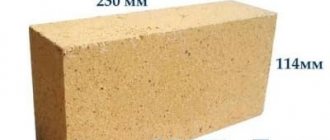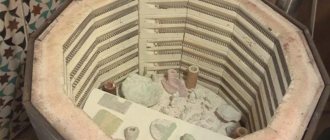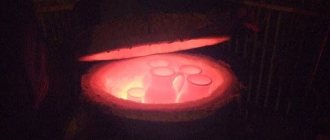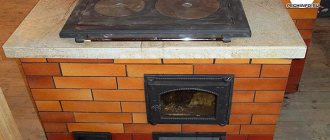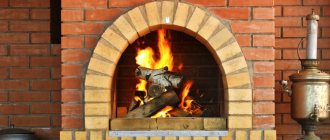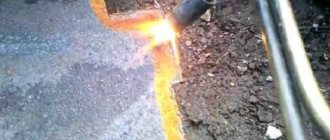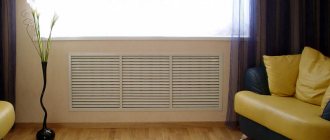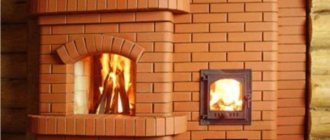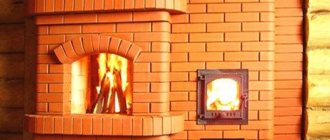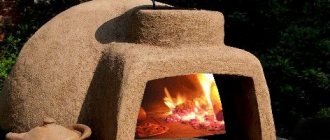What to look for when choosing a stove?
Muffle units are more suitable for amateur ceramists. For professionals engaged in more or less large-scale activities, the best option is camera equipment. When choosing a device, you need to rely on:
- on the volume of daily firing;
- product dimensions;
- electrical wiring requirements (some units are designed for three phases).
The format of loading ceramics is also important. You need to build on your own preferences and financial capabilities. Vertical loading equipment will be appreciated by specialists with a limited budget. Moreover, the result in the “cheap” case is no worse than in the other case. The degree of comfort in viewing products from above depends on individual characteristics.
Figure 7. Top-loading wood burning equipment
When loading horizontally, it is not so easy to assess the distance between products, but there is an excellent overview of the tiers. To get a 360-degree view of the ceramics being processed, you should purchase bell-type furnaces. It is also the most expensive.
The cost of budget, “home” models starts from 30,000 rubles. The lower price level for professional options is about 100,000 rubles. The price of powerful, productive furnaces reaches half a million rubles.
Figure 8. Furnace chamber with hot ceramics
Types of furnaces
There are different types of thermal energy sources:
- The oldest is the wood stove. The masters kept the secrets of firing and passed them on only to their students. Today, wood burning is very rare. Technological types have replaced them.
- The most popular is natural gas. With forced air injection, products can easily be heated to temperatures above 1500 °C. Gas equipment is easy to make with your own hands, and gas can be purchased in liquefied form in cylinders.
- The most high-tech is electricity. Electric spirals are evenly laid inside the oven, quickly and accurately heating the chamber with the products. Such equipment is more difficult to manufacture; high voltage requires compliance with safety precautions and electrical installation rules.
Photo 1. Small electric kiln for firing ceramics with evenly laid out spirals inside.
Wood-burning: structure and principle of operation
This is a great option for a beginner potter. It does not require large material costs to manufacture, and dry firewood is available everywhere. Wood stoves come in several types:
Earthen
A descendant of the ancient technology of burning in a fire flame. Above the narrow pit - the firebox - a clay roof is built on which the products are laid. A vault of bricks or strips of clay is built around the products, and a smoke hole is left at the top. The design works like this: charcoal is burned in the firebox, which gives a high temperature and does not smoke.
Hot gases without flames pass through the chamber with the products, heating them, and exit through the hole at the top. The temperature is regulated by the amount of coal and the “latch” on the chimney. After cooling, the stove roof is disassembled and the finished products are taken out.
Such a stove is suitable for one-time work, since each time you have to lay it out again. But, despite the labor intensity, the option is the cheapest - the cost of components is zero.
Brick
They are assembled from fired clay bricks and fire-resistant fireclay bricks. The operating principle is similar to earthen ones. They consist of a firebox with a grate, a chamber for products and a chimney.
Photo 2. Kiln for firing ceramics made of refractory bricks with a chimney and firebox on the street, next to the house.
The difference is that the design is reusable and more efficient. Products are placed into the chamber through a collapsible wall or door; the stove can be heated with wood - the flame does not reach the products.
Reference! It is important to use dry firewood, otherwise the products will pick up moisture and become cracked. Brick has high thermal conductivity, the stove cools down, so this design is voracious
Metal with lining
Thanks to the use of basalt and kaolin insulation, a wood-burning stove becomes more heat-resistant and efficient. Such a stove consists of a firebox on which a metal container is installed.
Photo 3. A ceramic kiln with an unheated metal body and lining has heat-resistant properties.
The walls and roof are insulated with non-flammable material; sometimes the metal frame does not even heat up. The heat from burning wood in the firebox rises, heating the products, and the cooled streams of air descend and rush through the chimney into the chimney. These stoves are much more economical than brick stoves and are easy to manufacture.
The downside is the need to use expensive insulation, the plus is the durability and mobility of the structure.
Gas
Has a number of advantages:
- The gas burns completely and contains no moisture.
- Gas burners develop high temperatures.
- Temperature regulation is easy.
A gas furnace for firing ceramics is made using different technologies:
Muffle. A muffle is a separate sealed chamber in which ceramics are heated and makes it possible to produce earthenware and porcelain, since the workpieces do not come into contact with hot gases - combustion products.
The muffle is placed in the combustion chamber and the flames are distributed evenly over the entire area.
Chamber. Excellent for firing conventional ceramics. Products are loaded into an insulated chamber through which hot gases pass. The burner is installed lower and separated by a partition. The temperature distribution occurs evenly, when cooled, the gases exit into a special hole at the bottom of the chamber.
Gas equipment
A gas ceramic kiln is good for regularly producing small batches of clay items. The maximum temperature range is 1100-1300 degrees. Capable of operating on natural gas and propane.
Figure 4. Gas unit
There are frontal and vertical configurations. The burner can be placed both inside and outside. In the first case, electric ignition takes place, and in the external version, the element is located near the chamber, and the heat is “blown in” through a special hole. One free-standing burner is enough to service several furnaces.
*
The basic package includes the following elements:
- gas pipelines (for supply/discharge);
- burner;
- coolant duplication system.
Among the advantages of devices of this type:
- relatively low cost;
- low operating costs;
- uniform heat distribution;
- high heating speed (with an internal burner, heating occurs faster);
- possibility of equipment with automatic equipment;
- safety.
Device
Regardless of whether you are making a ceramic kiln from a barrel or using an industrial version, each design is made from several main parts:
- The outer casing of the unit can be made of stainless steel or an old refrigerator. Its main task is to create a power frame around the internal firebox and oven. Steel structures are not competitors to brick buildings, which will last a long time. To manufacture the steel outer casing we use steel, sheet thickness from 2 mm.
- Inner layer of thermal insulation. To do this, use fireclay brick or other heat-insulating material that can withstand heating temperatures above 2000. The performance of the device and heat loss depend on the heat-insulating qualities of this layer.
- A layer of thermal insulation between the inner layer and the oven body. Use mineral wool, basalt wool, and perlite. It is not recommended to use sheet asbestos. At high temperatures, the material releases substances harmful to humans.
- Chambers for laying clay products and heating elements. For electric furnaces, nichrome spirals or air heating elements are used. These devices are installed in grooves that are selected in fireclay bricks. Nichrome wire is the best option for electric furnaces. Gas burners are installed for gas.
Lining
The dimensions of the furnace are multiples of the dimensions of lightweight fireclay bricks ШЛ-0.5, standard size No. 5. Brick dimensions 230x113x65. In the photo it is white. Yellow ones are some other refractory brick with slightly different dimensions. But for my needs this is not important. If necessary, I will make everything from ShL-0.5. Since lining a door with bricks is another task, so for lining the door I used a Cerablanket mat (blanket) from the Sukholozhsky plant.
resistance up to 1260 g (in practice, withstands the direct flame of a gas burner). Sold by the meter in rolls 610 mm wide, thickness from 13 to 50 mm. I would like to warn you against some ambushes that may await you when making the lining. First of all, I want to warn you if you are tempted to use asbestos. Yes, it melts at 1500 degrees, but at 800 degrees it loses chemically bound water and turns into powder. Therefore, products made from it, such as cardboard or cord, can work up to this temperature.
Regarding the use of fibrous materials on a mineral (basalt) basis, I will repeat what I wrote on one of the forums. It's almost the same thing. Produced by melt blowing. Holds temperature well. But they have a binder that will not withstand even 250 degrees. But on the Internet, cunning sellers cite the fire resistance of the fiber itself. Formally, they are right. But they don’t write that after the first calcination the binder will burn out and they will fall off in a heap. There are varieties with a refractory binder, but there is very little information. Only indirect signs - for example, intended for baths and fireplaces. And again the fire resistance of the fiber itself is tested. So if there is a risk of flying, it is better to use already tested ones.
Of the ones I have tested, mullite-silica felts are most suitable, for example, MKRVH-250 (1300 g) and this Cerablanket. Since mats still had to be used for the door, the vault was also made from it. If necessary, I will lay out everything with an SHL brick, since the camera is already sized for it. The mats are attached to pins made of stainless electrodes. One end is sharpened, the other is welded to the furnace wall with a stainless electrode. The holders are pieces of stainless steel sheets with cross-cut slits.
Operating rules
The electric oven may only be plugged into a reinforced socket. You can also run a large cross-section wire directly from the shield. In addition, it would be useful to install a circuit breaker.
Since this device model has exposed wires, you need to be extremely careful with it. Do not touch the coils while the oven is running. To avoid accidents, it is recommended to install a limit switch on the door, which will turn off the unit when the door is opened. If you are not very good at electrical work, seek the help of a specialist who can help make the device as safe as possible, including grounding it.
Technical parameters of bricks
Brick size and shape
One of the unchanging rules for constructing stoves is the accuracy of the design. Most projects are designed for specific brick sizes. Therefore, which brick is best to build a stove from is a very important question.
Brickwork plans usually indicate not only the number of bricks, but also their dimensions. It is generally accepted that the standard dimensions of bricks correspond to the dimensions of a single type - length 250 mm, width - 120 mm and height 65 mm. This is considered the “gold standard”. However, it is worth noting that these are the dimensions established by the Soviet standard. Today, in addition to this traditional size, there are other sizes used for laying stoves:
- “Euro standard” - with the same length and height as the normal standard, its width is 85 mm (it is often designated 0.7 NF);
- Thickened brick (KU) - differs from the usual format in height, it is 88 mm (designation 1.4 NF);
- Single modular brick (KM) - length is 288 mm, width 138 mm, height 65 mm (designation 1.3 NF);
- Thickened brick with horizontal voids (KUG) has dimensions of a thickened brick of 250x120x88 mm (indicated by 1.4 NF).
There is another specific brick for laying stoves - a stove module, its dimensions are 230mm x 125mm x 65mm. Despite the fact that this standard is considered outdated, many successful stove designs have designs designed specifically for this size. The popularity of this kiln standard is such that many manufacturers of refractory bricks for individual kilns still produce bricks with dimensions specifically for the kiln module - 230x114x40 or 230x114x65 mm.
For the construction of firebox vaults and cladding arches, there is also a specific type of brick - wedge-shaped or arched. Its peculiarity is that the dimensions indicate both the wide side and the narrowed side, for example, 230x114x65/45 mm.
Ceramic bricks for stoves used for decoration can have different shapes. For example, have rounded corners, convex or concave sides, or have a glossy surface. The use of this type of material must be indicated in the ordinary furnace laying diagram.
Brick strength
The second point that you need to pay attention to when choosing bricks for laying stoves is brand strength. This characteristic shows how much load a brick can withstand without showing signs of deformation. The marking is usually indicated by the letter “M” and a number corresponding to the maximum load expressed in kilograms / square centimeter
Thus, the M150 marking is allowed for the construction of most stove designs. M 200 is suitable for the construction of a furnace for heating two floors. But higher grades, for example M-300 or M-500, are usually not used for the construction of stoves. The fact is that special chemical additives are used to mold a material of such density, so when heated, such a material partially loses its properties, which negatively affects the condition of the structure.
Frost resistance, thermal conductivity and hygroscopicity
Frost resistance of brick is especially important for the construction of stoves in houses where permanent residence is not planned in cold weather. It is usually designated by the letter F, next to which is indicated the minimum number of freeze-thaw cycles without loss of strength and the beginning of the process of mechanical destruction
This indicator is important for such structural elements as the base and head of the chimney pipe.
When choosing bricks for masonry, you should also pay attention to such an indicator as thermal conductivity - the ability of the material to retain heat
This is especially important for laying the walls of the firebox and chimney. For these purposes, material is taken with indicators not lower than 0.61 W/m×°C
For these purposes, material with indicators not lower than 0.61 W/m×°C is taken.
But as for hygroscopicity, you should choose the material with the lowest indicator. The lower the coefficient, the less the brick is able to absorb moisture. For the base and chimney, this is a very important indicator of the quality of the brick, since these are the parts of the structure that are most susceptible to moisture.
Method two. We make a stove without having a metal casing at hand
The manufacturing process in this case is not much different from that described above, but there are definitely some nuances here. Let's start with the fact that the working volume of the design below will be about 13 liters. The spiral, as mentioned above, can warm up to a thousand degrees in just 1.5 hours, while the temperature of the outer walls of the device will not exceed 100 degrees. The algorithm of actions should be as follows.
Step 1. First, using a 4x2 centimeter profile pipe (with a square cross-section), we build a stand for the device. After this, we paint the finished stand with enamel.
Step 2. We attach a sheet of galvanized steel on top of the stand (its thickness should be approximately 0.1 centimeters), using “metal” self-tapping screws.
Step 3. We make the walls from fireclay bricks and a special fireplace composition (everything is the same as in the previous version). After the solution hardens, we make grooves for the spiral.
Step 4. We assemble the bottom from brick separately, and use the same mortar for fastening. Before continuing work, wait until the structure is completely dry. Do not forget to wet each brick immediately before laying.
Step 5. We lay a thermal insulation layer on top of the metal base (we can use the same basalt wool for this). In order to maximize compaction of this layer, it must be moistened before fixing the brick bottom.
Step 6. We continue the traditional laying of the stove, but we try to ensure that all voids and seams are carefully filled.
Step 7. We traditionally make the lid for the chamber from fireclay bricks, but at the same time we fasten them together with a metal tie.
Step 8. Place the spiral in the prepared grooves and insulate the structure from the outside with thermal insulation material. Next, we cover everything with sheets of galvanized steel, which are cut according to the dimensions of the resulting chamber.
As you can see, this requires knowledge not only in the furnace business, but also in the field of electricity. You can see another possible manufacturing method in the video below.
Video - wood burning stove
How to make a Bubafonya stove yourself
Previously, we talked about how to make a Babufonya stove on your own, in addition to this article, we advise you to read this information, see all the details here
Comments
I have two muffle stoves at home, a small one (made to order) just in the room and a large one (Paragonovsky for porcelain) in the kitchen. Both have programmers, they work from a regular network, a large oven consumes 300 rubles worth of electricity. for 24 hours of continuous operation. There are no problems using it at home, you just need to have enough free space around the stove.
I don’t make porcelain dolls, but since I work in a metallurgical laboratory, where muffle and not-so-muffle stoves are in abundance, I’d like to throw in my two cents.
We have everything connected to separate sockets, which are directly connected to the panel. No stove is connected to the same outlet as its neighbor under any circumstances.
There is always at least 0.5 meters of free space, plus, it is advisable that no rags, wallpaper or any other well-burning things are just lying around (we keep all the potholders on a separate stand).
Furnaces are always FAR from exits (windows, doors, hatches), as well as their sockets. No adapters or pilot extensions.
Grounding! AND NOT to the battery
